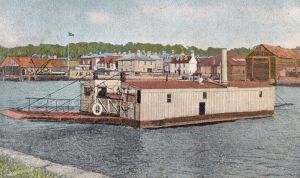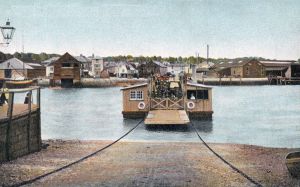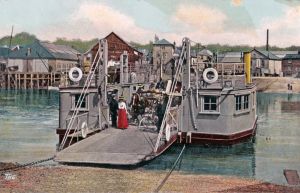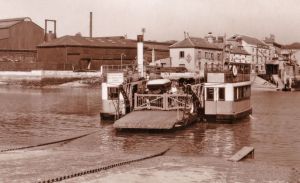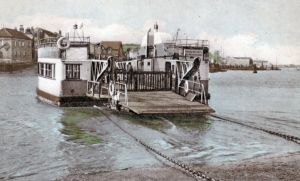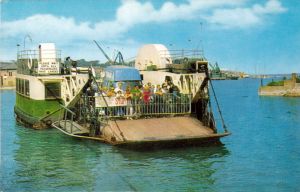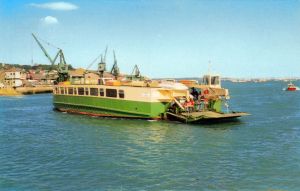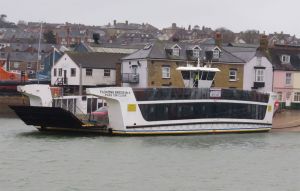Cowes Chain Ferry (aka Floating Bridge)
The Cowes Chain Ferry (widely referred to as 'the Floating Bridge') is operated by the Isle of Wight Council across the River Medina between Cowes and East Cowes, Isle of Wight. The alternative route by road is some 10 miles - in the mid 19th century, travelling by road would have been considerably more onerous than today.
1859 Chain Ferry and Floating Bridge Company
The Hampshire Advertiser in 5 March 1859 saw a call to shareholder of the West and East Cowes Floating Bridge Company of £3 per share. The Isle of Wight Observer 24 September 1859 reported that the new ferry was nearing completion at Itchin (sic), Southampton. However they repeated their opinion that a swing bridge would have been far better; ‘nevertheless, anything upon the present aboriginal system of transit must be for the public good.’ At the end of November the IW Observer 26 November 1859 reported that the ferry had commenced operation and on the first day had run back and forth until about 4.30 when, owing to the low spring tide, she was unable to reach the East Cowes side by about 30 feet, and had to take the passengers back to West Cowes.
On a March morning 1867, about 1 o’clock, while the chain ferry was moored for the night, a French schooner coming down the river with a cargo of cement crashed into the bridge. The bridge sank just below low water mark leaving just her funnel and upper deck showing above the water[1]. She was later raised and repaired and was back in service
1867 Change in ownership.
A meeting of the West and East Cowes Ferry Company was held in September 1867 to discuss unfair completion by the Southampton and Cowes Steamboat Company (forerunner of Red Funnel). The Steamboat Company, which operated the Southampton to West Cowes ferry, had been running a boat, the Precursor, from the West Cowes pontoon to East Cowes, thus operating in completion with the Floating Bridge Company. The only course open to the Company was to go to law to prevent the Steamboat Company operating their boat. However, the Steamboat Company had offered to purchase the Floating Bridge Company at £12 to £13 a share, which had only cost £10 each. The meeting decided to accept the offer and subsequently the Steamboat Company took over the chain ferry[2].
1882 Chain Ferry
A new chain ferry was ordered by the Steamboat Company in 1881 from Messrs Napier and Sons, of Cross-house, Southampton. The vessel was 46 feet long (without prows), 29 feet broad with a drought of 4ft 2in amidships; there were cabins at the 4 corners. The carriageway was 12ft wide and could take two vehicles side-by-side. The engines were compound inverted condensing type[3].
The 1882 chain ferry went into operation in February, an observation made by a newspaper “that it would not be nearly as nice [as the old one] had a good platform on the top, which was a great attraction. .. however [it] goes at a good rate of speed.”[4]
1896 Chain Ferry
1896 saw an order by the Steamship Company for a new chain ferry placed with W. White & Sons of West Cowes.
1901 Change in ownership
In 1901 the Cowes Ferry Bill was approved by Parliament under which the Cowes and East Councils were able to acquire the ferry rights and ferries. In October 1902 the district Councils paid the Southampton and Isle of Wight Steam Packet Company £3997 for the two bridges, land, plant, &c., as agreed by arbitration[5].
1909 Chain Ferry (Bridge No. 1)
The Ferry Committee of the Councils ordered a new Chain Ferry from William White and Sons in 1908 having accepted their tender of £2772 (excepting the lighting and machinery for raising the prows). With this ferry, access to the upper deck was again made available to passengers[6]. Being the first new bridge ordered since the Councils acquired the operation, the new ferry would be given the number one.
About this time, at East Cowes, Ferry Road was constructed to give improved access to the ferry from York Avenue by the demolition of old properties; and part of Bridge Road (formerly Floating Bridge Road), which ran from Clarence Road to the ferry, was incorporated into the J. S. White’s works.
1924 Other options for crossing the river
In 1924, Sir John Wolfe Barry and Partners provided the Ferry Committee with a report offering various options for communicating between Cowes and East Cowes. The links they proposed were (all figures ‘not less than’ and not including any allowance for purchasing any land – figures in brackets are rough 2021 ):
- A fixed bridge, £200,000 (about £12.5m),
- A two way traffic tunnel. £300,000 (£18.7m),
- A single way tunnel, with traffic control, £180,000 (£11.25m),
- An opening (low level) bridge £70,000 (£4.4m);
- A transporter bridge £95,000 (£6m);
- A second floating bridge (to increase capacity) located south of the existing bridge and connecting between Clarence Road with Arctic Road, £5,500 plus £6,000 for the actual ferry (total £720k)
The Ferry Committee recommended the last, (cheapest) option, although nothing seems to have happened to implement the proposal[7].
1925 Chain Ferry (Bridge No. 2)
A tender from J. S. White & Co. of £8250, (being the lowest of three from local firms) was accepted for a new bridge[8].
Steam Bridge No. 2 was used as a stand-by ferry until 1952 when it was sold to the Bournemouth-Swanage Motor Road and Ferry Company for £8,000[9].
1933 Amalgamation of Councils
The Local Government Act of 1933 merged East Cowes UDC merged with the Cowes UDC, so the Floating Bridge came under one authority.
1936 Chain Ferry (Bridge No. 3)
No 3 Floating Bridge was launched by J. S. White’s at East Cowes in May 1936 The new bridge was powered by electricity which was generated onboard by diesel engines, this was a significant change as all previous bridges had been steam powered. The overall length was 107ft, the pontoon 52ft 6in and the carriageway width 16ft 3in. It could carry about 150 more passengers than the previous J. S. White built bridge[10].
1952 Chain Ferry (Bridge No. 4)
In 1950, the Ferry Committee accepted a tender of £24,700 from Messrs J. Bolson and Son, of Poole for a new Diesel-electric chain ferry[11].
Bridge No. 4 went into operation in early 1952 and Steam Bridge No. 2, which had been used as a stand-by ferry, was sold to the Bournemouth-Swanage Motor Road and Ferry Company for £8,000[9].
1974 Local government reorganisation
With the local government reorganisation in 1974, the operation of the bridge came under the Isle of Wight County Council.
1976 Chain Ferry (Bridge No. 5)
In 1974, the Isle of Wight County Council placed an order for a new Chain Ferry with Groves and Guttridge of East Cowes, part of the Fairey Group. The contract was quoted as having a value of almost £250,000. Power was by diesel engines through hydraulic pumps and motors. Hydraulics would also be used to raise and lower the prows. The overall length would be 110ft, the pontoon 87ft. 6in., overall width 42ft, and dead weight 65 tons[12].
The No. 5 Bridge went into operation in January 1976 but broke down after only six hours operation and the 1952 bridge, which had retained for use when the new bridge was being serviced, was brought back into operation while the new bridge was repaired[13].
2017 Chain Ferry (Bridge No. 6)
In 2016, a £3.2 million contract was awarded by the Isle of Wight Council to Welsh firm Mainstay Marine Solutions for a new Chain Ferry (Bridge No. 6)[14].
Bridge No. 6 went into service in May 2017 but has suffered from many technical problems.
- ↑ IW Observer 9 March 1867
- ↑ Isle of Wight Observer - 9 March 1867
- ↑ Isle of Wight Observer - 4 February 1882
- ↑ Isle of Wight Observer - 18 February 1882
- ↑ Isle of Wight County Press - 12 October 1901
- ↑ Isle of Wight County Press – 31 October 1908
- ↑ Isle of Wight Count Press 20 September 1924
- ↑ Isle of Wight County Press - 22 November 1924
- ↑ 9.0 9.1 Isle of Wight County Press – 22 March 1952
- ↑ Isle of Wight County Council - 2 May 1936
- ↑ Isle of Wight County Press - 20 May 1950
- ↑ Isle of Wight County Press - 2 November 1974
- ↑ Isle of Wight County Press - 31 January 1976
- ↑ Isle of Wight County Press – 1 April 2016
